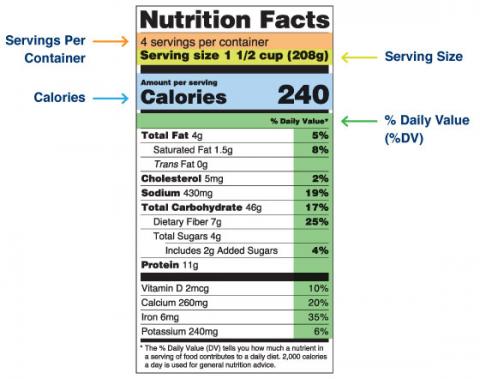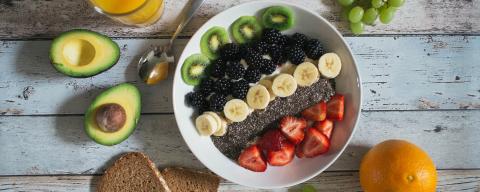Enjoying Meals While Managing Diabetes
According to the Centers for Disease Control and Prevention (CDC), 1 in 10 Americans have diabetes.1 About one in four of these people are not yet aware they have the disease!2 Diabetes is when the body does not make enough of a hormone called insulin, or that the body is not responding to insulin appropriately.1,3,4 Type 1 Diabetes is when the body does not provide enough or any insulin for reasons that are not understood. The peak age Type I Diabetes is diagnosed is 13-14 years of age.5 Type II Diabetes (Diabetes Mellitus) is when the body becomes unable to efficiently respond to or use the insulin which is released.
Insulin has the important job of moving sugar out of the bloodstream and into the body cells to be used as energy.4,6 When insulin is unable to do this job, blood glucose (the same as blood sugar) is very hard to maintain within a healthy range. When blood glucose levels are too high or too low for a significant portion of the day, consequences may develop overtime. These consequences may include foot problems, gum disease, skin infections, nerve problems, kidney disease, blindness, and more.4
Although uncontrolled diabetes can lead to adverse effects, there are many ways to manage blood glucose levels such as exercise, medication, monitoring blood glucose levels, and diet.1 This article will address dietary techniques, which are a very powerful and effective tool for maintaining blood glucose levels, while still enjoying mealtime. Medications and other medical interventions for treatment of Diabetes should be discussed with your doctor. The American Diabetes Association’s goals for managing diabetes include addressing an individual’s nutrition needs based on their personal preferences and to maintain the pleasure of eating.6
All macronutrients should be present at each meal to provide balance and adequate nutrition. Carbohydrates, fat, and protein (macronutrients) are all used for energy by the body. When managing diabetes, it is important to focus on carbohydrates because they break down directly into glucose/sugar. Carbohydrates should not be eliminated in diabetes management but be consumed consistently and in moderation so that blood glucose does not go too low or too high.
Carbohydrates are one of the three main nutrients found in food and beverages. They are an essential source of energy for the body. The form or type of carbohydrate will influence how quickly it is broken down into glucose and brought into the bloodstream. The faster carbohydrates are broken down the more likely it is to bump your blood glucose out of range.
For this reason, whole grain and high-fiber sources of carbohydrates take longer to digest and will release glucose more steadily. This is ideal for managing diabetes! You can check the nutrition facts label to see if a food is high in fiber or contains whole grains. Whole grains will be labeled as “whole grain” on a food package or in the ingredients list. Fiber can be found on the nutrition facts label of a food product. Any food with a 20% or higher percent daily value on the right-hand side of the food label can be considered to be high in fiber.7 Fruits and vegetables are great sources of fiber.

Foods containing added sugars are likely to result in a fast spike in blood glucose followed by a quick drop. Added sugars can be found in the ingredient list on a food product and may be called sucrose, dextrose, table sugar, syrups, honey, and sugars from concentrated fruit or vegetable juices.8 It is ideal to swap out foods high in added sugar with foods like fruits, vegetables, whole grains, or high-fiber carbohydrates.
Diabetes Plate Method 9, 10
The Plate Method is a visual method to ensure you are eating balanced meals that help to keep your blood glucose within the desired range.
- Use a standard sized-plate with a 9-inch diameter
- Half of the plate should be filled with non-starchy vegetables.
- These will provide vitamins, minerals, and fiber without creating your blood glucose to spike.
- Non-starchy vegetables may include green beans, bell peppers, broccoli, salad, mushrooms, zucchini, Brussel sprouts, and many more!
- The other half of the plate is split between a carbohydrate food and a protein food.
- A carb food may include a grain, pasta, fruit, milk, tortilla, bread, or a starchy vegetable such as potato, squash, or corn.
- Protein sources should be lean choices which are lower in saturated fats. These may include fish, shellfish, skinless chicken or turkey, tofu, or lean deli meats.

Basic Carb Counting11
Basic carbohydrate counting can improve blood glucose and give you a rough idea of how many carbs you are consuming per meal. One serving or “count” of carbs provides about 15g of carbs. Examples of one serving of carbohydrate include ⅓ cup of rice or pasta, 1 cup milk, 1 cup berries, 13 chips, 1 slice of bread, or 3 cups plain popcorn.
For weight maintenance, women should consume roughly 3-4 carbohydrate equivalents (45-60g) of carbs per meal and 1 carbohydrate equivalent (15g) per snack. Men should consume about 4-5 carbohydrates (60-75g) per meal and 1-2 (15-30g) per snack.6 Carb counting can help with portion control, consistency, and flexibility during mealtime. Please see the attached link to see what portion of your favorite foods count as one carb equivalent! https://med.virginia.edu/vcdpe/wp-content/uploads/sites/287/2015/12/Basic-Carbohydrate-Counting.pdf
References
1 CDC. Type 2 Diabetes. Centers for Disease Control and Prevention. Published December 16, 2021. Accessed February 21, 2022. https://www.cdc.gov/diabetes/basics/type2.html
2 Diabetes | NIDDK. National Institute of Diabetes and Digestive and Kidney Diseases. Accessed March 8, 2022. https://www.niddk.nih.gov/health-information/diabetes
3 Understanding Diabetes. Accessed February 21, 2022. https://www.eatright.org/health/diseases-and-conditions/diabetes/understanding-diabetes
4 Diabetes Complications. Accessed February 21, 2022. https://medlineplus.gov/diabetescomplications.html
5 CDC. Just Diagnosed With Type 1 Diabetes. Centers for Disease Control and Prevention. Published March 25, 2021. Accessed March 25, 2022. https://www.cdc.gov/diabetes/basics/diabetes-type-1-diagnosis.html
6 Kane, K. Prelack, K. Nutritional Management of Diabetes Mellitus. Advanced Medical Nutrition Therapy. First edition. Jones & Bartlett Learning, LLC; 2019: pages.
7 Nutrition C for FS and A. Using the Nutrition Facts Label: For Older Adults. FDA. Published online February 25, 2022. Accessed March 8, 2022. https://www.fda.gov/food/new-nutrition-facts-label/using-nutrition-facts-label-older-adults
8 CDC. Know Your Limit for Added Sugars. Centers for Disease Control and Prevention. Published November 28, 2021. Accessed February 21, 2022. https://www.cdc.gov/nutrition/data-statistics/added-sugars.html
9 http://www.intechnic.com I. What is the Diabetes Plate Method? Diabetes Food Hub. Accessed February 21, 2022. https://www.diabetesfoodhub.org/articles/what-is-the-diabetes-plate-met…
10 CDC. Meal Planning. Centers for Disease Control and Prevention. Published March 11, 2021. Accessed February 21, 2022. https://www.cdc.gov/diabetes/managing/eat-well/meal-plan-method.html
11 Basic-Carbohydrate-Counting.pdf. Accessed February 21, 2022. https://med.virginia.edu/vcdpe/wp-content/uploads/sites/287/2015/12/Basic-Carbohydrate-Counting.pdf
Check Out Our New Health & Well-Being Page
Our specialists help create healthy people and healthy places in New Hampshire.
Featured LINK
Mental Health Resources for New Hampshire - a printable county-specific guide to help New Hampshire residents find local, state, and national mental health resources.
